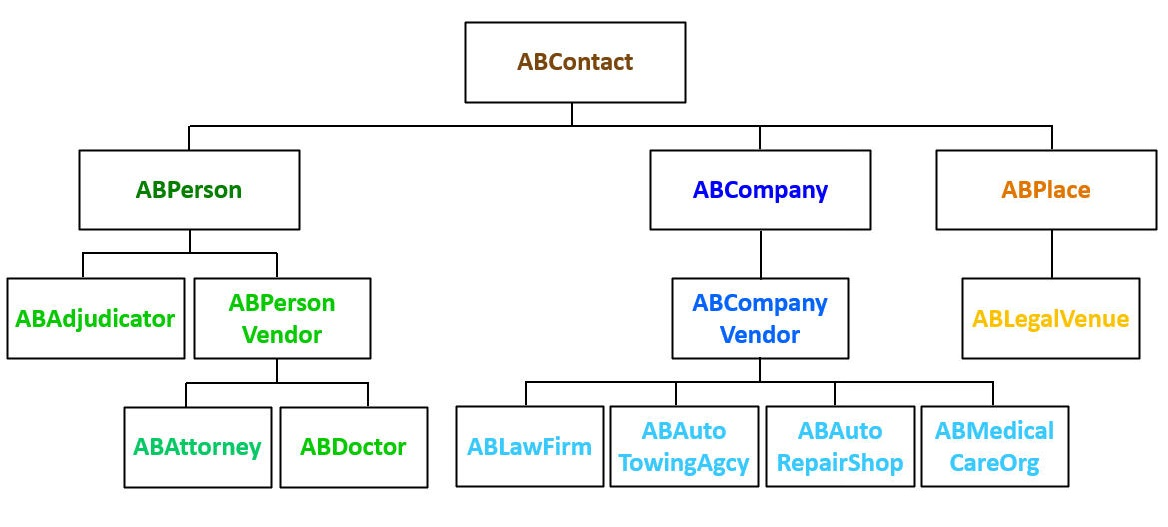Overview of contacts in ContactManager
ContactManager is a Guidewire application that serves as the system of record for contacts in a Guidewire implementation.
ContactManager is integrated with the other InsuranceSuite core applications owned by the insurer (BillingCenter, ClaimCenter, and PolicyCenter). Contacts can be created and edited in any of the core applications. When this occurs, the core application sends information about the new or edited contact to ContactManager. ContactManager then sends that information to the other core applications as needed.
Connecting to ContactManager directly
People who are responsible for managing contacts can log into ContactManager directly and execute tasks there.
When connecting to an instance of ContactManager, be aware of the following:
- The default port is 8280.
- The application code for ContactManager is
ab. (abstands for "address book").
To connect to a default instance of ContactManager on your local machine, the URL is:
http://localhost:8280/ab/ContactManager.doThe ABContact subtype
All ContactManager contacts are stored in an instance of the ABContact
data model entity. The ABContact entity is subtyped. It is broken down into
three main subtypes: ABPerson, ABCompany, and
ABPlace. These subtypes contain additional subtypes. For example,
ABPerson contains ABAdjudicator,
ABPersonVendor, and ABPolicyPerson.
The following diagram identifies most of the subtypes in the ABContact
hierarchy.

The hierarchical organization helps to model database information about contacts.
Information common to all contacts, such as phone numbers, is declared at the
ABContact level. This information is inherited by all subtypes.
Information specific to a person, such as First Name, Gender, and Date of Birth, is declared
at the ABPerson level. It is inherited by all of its subtypes. However,
information declared in the ABPerson subtype is not available to
ABCompany or ABPlace or any of their subtypes.
You can create a contact instance at any level in the hierarchy except for the top level.
ABPolicyPerson, ABPolicyCompany,
ABUserContact. These are legacy subtypes and are no longer recommended
for use. Contact tags
A contact tag is a tag that identifies one or more broad relationships that the contact has with the insurer.
The base application includes three tags:
- Client (a policy holder)
- Claim party (a contact involved in a claim)
- Vendor (a contact that provides service for a claim)
Contact tags provide more flexibility for categorizing contacts than subtypes. A contact can only be of one subtype. Therefore, it is hard to reflect that a given contact may have multiple roles with the company (such as a doctor who is both a claim party and a vendor, and could also possibly be a client). However, a contact can have multiple tags. Also, once created, a contact's subtype is fixed. However, contact tags can be added and removed at any time.
Addresses and phone numbers
An ABContact typically includes information on how to contact the
corresponding person or company.
An ABContact can have one or more postal addresses. Each address is
stored in a separate Address data model entity. Every
ABContact has an array of zero or more addresses. If an
ABContact has at least one address, you can specify exactly one of the
addresses as the primary address. The information you can store in an address varies based
on the country of the ABContact. For example, an address in Canada can have
a Province value but cannot have a State value.
An ABContact can have one or two email addresses. These are stored
in the EmailAddress1 field (for primary email addresses) and the
EmailAddress2 field (for secondary email addresses). Each field accepts a
String value.
Depending on the subtype, an ABContact can have up to four phone
numbers. These are stored in the CellPhone,
FaxPhone, HomePhone, and WorkPhone
fields. There is also a PrimaryPhone field that identifies one of the phone
numbers as the primary phone number.